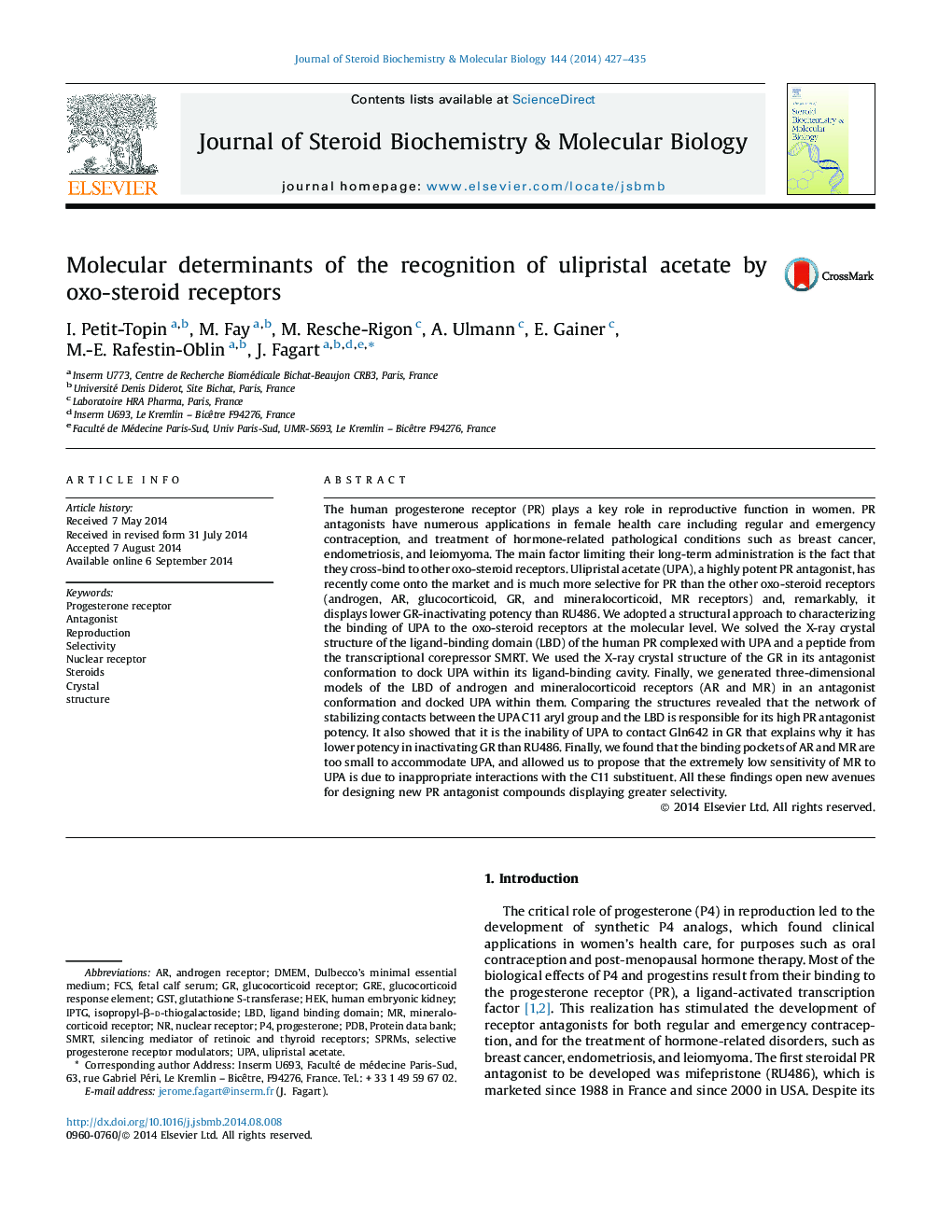| کد مقاله | کد نشریه | سال انتشار | مقاله انگلیسی | نسخه تمام متن |
|---|---|---|---|---|
| 8338419 | 1541005 | 2014 | 9 صفحه PDF | دانلود رایگان |
عنوان انگلیسی مقاله ISI
Molecular determinants of the recognition of ulipristal acetate by oxo-steroid receptors
ترجمه فارسی عنوان
تعیین کننده های مولکولی تشخیص استاف الیوپریستال توسط گیرنده های اکسستروئید
دانلود مقاله + سفارش ترجمه
دانلود مقاله ISI انگلیسی
رایگان برای ایرانیان
کلمات کلیدی
IPTGGREFCSuPAHEKGSTPDBLBDisopropyl-β-d-thiogalactosideDMEMSMRTAntagonist - آنتاگونیستulipristal acetate - استات ulipristalSteroids - استروئیدSelectivity - انتخابیCrystal - بلورselective progesterone receptor modulators - تعدیل کننده های گیرنده پروژسترون انتخابیReproduction - تولید مثل یا زادآوریDulbecco’s Minimal Essential Medium - حداقل ضروری متوسط Dulbeccoligand binding domain - دامنه اتصال لیگاندStructure - ساختار یا سازهfetal calf serum - سرم گوساله جنینGlucocorticoid response element - عنصر پاسخ گلوکوکورتیکوئیدProtein Data Bank - پروتئین بانک اطلاعاتیProgesterone - پروژسترونhuman embryonic kidney - کلیه جنین انسانglutathione S-transferase - گلوتاتیون S-ترانسفرازAndrogen Receptor - گیرنده آندروژنیMineralocorticoid receptor - گیرنده مینرالوکورتیکوئید Progesterone receptor - گیرنده پروژسترونglucocorticoid receptor - گیرنده گلوکوکورتیکوئیدNuclear receptor - گیرنده هستهای، گیرندههای هستهای
موضوعات مرتبط
علوم زیستی و بیوفناوری
بیوشیمی، ژنتیک و زیست شناسی مولکولی
زیست شیمی
چکیده انگلیسی
The human progesterone receptor (PR) plays a key role in reproductive function in women. PR antagonists have numerous applications in female health care including regular and emergency contraception, and treatment of hormone-related pathological conditions such as breast cancer, endometriosis, and leiomyoma. The main factor limiting their long-term administration is the fact that they cross-bind to other oxo-steroid receptors. Ulipristal acetate (UPA), a highly potent PR antagonist, has recently come onto the market and is much more selective for PR than the other oxo-steroid receptors (androgen, AR, glucocorticoid, GR, and mineralocorticoid, MR receptors) and, remarkably, it displays lower GR-inactivating potency than RU486. We adopted a structural approach to characterizing the binding of UPA to the oxo-steroid receptors at the molecular level. We solved the X-ray crystal structure of the ligand-binding domain (LBD) of the human PR complexed with UPA and a peptide from the transcriptional corepressor SMRT. We used the X-ray crystal structure of the GR in its antagonist conformation to dock UPA within its ligand-binding cavity. Finally, we generated three-dimensional models of the LBD of androgen and mineralocorticoid receptors (AR and MR) in an antagonist conformation and docked UPA within them. Comparing the structures revealed that the network of stabilizing contacts between the UPA C11 aryl group and the LBD is responsible for its high PR antagonist potency. It also showed that it is the inability of UPA to contact Gln642 in GR that explains why it has lower potency in inactivating GR than RU486. Finally, we found that the binding pockets of AR and MR are too small to accommodate UPA, and allowed us to propose that the extremely low sensitivity of MR to UPA is due to inappropriate interactions with the C11 substituent. All these findings open new avenues for designing new PR antagonist compounds displaying greater selectivity.
ناشر
Database: Elsevier - ScienceDirect (ساینس دایرکت)
Journal: The Journal of Steroid Biochemistry and Molecular Biology - Volume 144, Part B, October 2014, Pages 427-435
Journal: The Journal of Steroid Biochemistry and Molecular Biology - Volume 144, Part B, October 2014, Pages 427-435
نویسندگان
I. Petit-Topin, M. Fay, M. Resche-Rigon, A. Ulmann, E. Gainer, M.-E. Rafestin-Oblin, J. Fagart,
